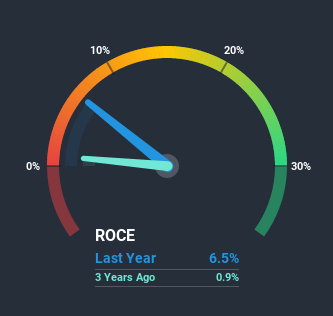
If we want to find a stock that could multiply over the long term, what are the underlying trends we should look for? Typically, we'll want to notice a trend of growing return on capital employed (ROCE) and alongside that, an expanding base of capital employed. Basically this means that a company has profitable initiatives that it can continue to reinvest in, which is a trait of a compounding machine. With that in mind, we've noticed some promising trends at Opera (NASDAQ:OPRA) so let's look a bit deeper.
Understanding Return On Capital Employed (ROCE)
If you haven't worked with ROCE before, it measures the 'return' (pre-tax profit) a company generates from capital employed in its business. Analysts use this formula to calculate it for Opera:
Return on Capital Employed = Earnings Before Interest and Tax (EBIT) ÷ (Total Assets - Current Liabilities)
0.065 = US$68m ÷ (US$1.1b - US$44m) (Based on the trailing twelve months to September 2020).
So, Opera has an ROCE of 6.5%. Ultimately, that's a low return and it under-performs the Software industry average of 9.8%.
Check out our latest analysis for Opera

Above you can see how the current ROCE for Opera compares to its prior returns on capital, but there's only so much you can tell from the past. If you'd like, you can check out the forecasts from the analysts covering Opera here for free.
What Can We Tell From Opera's ROCE Trend?
We're glad to see that ROCE is heading in the right direction, even if it is still low at the moment. The numbers show that in the last three years, the returns generated on capital employed have grown considerably to 6.5%. Basically the business is earning more per dollar of capital invested and in addition to that, 75% more capital is being employed now too. This can indicate that there's plenty of opportunities to invest capital internally and at ever higher rates, a combination that's common among multi-baggers.
What We Can Learn From Opera's ROCE
To sum it up, Opera has proven it can reinvest in the business and generate higher returns on that capital employed, which is terrific. Given the stock has declined 15% in the last year, this could be a good investment if the valuation and other metrics are also appealing. So researching this company further and determining whether or not these trends will continue seems justified.
If you'd like to know more about Opera, we've spotted 3 warning signs, and 1 of them is concerning.
While Opera may not currently earn the highest returns, we've compiled a list of companies that currently earn more than 25% return on equity. Check out this free list here.
When trading Opera or any other investment, use the platform considered by many to be the Professional's Gateway to the Worlds Market, Interactive Brokers. You get the lowest-cost* trading on stocks, options, futures, forex, bonds and funds worldwide from a single integrated account. Promoted
New: AI Stock Screener & Alerts
Our new AI Stock Screener scans the market every day to uncover opportunities.
• Dividend Powerhouses (3%+ Yield)
• Undervalued Small Caps with Insider Buying
• High growth Tech and AI Companies
Or build your own from over 50 metrics.
This article by Simply Wall St is general in nature. It does not constitute a recommendation to buy or sell any stock, and does not take account of your objectives, or your financial situation. We aim to bring you long-term focused analysis driven by fundamental data. Note that our analysis may not factor in the latest price-sensitive company announcements or qualitative material. Simply Wall St has no position in any stocks mentioned.
*Interactive Brokers Rated Lowest Cost Broker by StockBrokers.com Annual Online Review 2020
Have feedback on this article? Concerned about the content? Get in touch with us directly. Alternatively, email editorial-team (at) simplywallst.com.
About NasdaqGS:OPRA
Opera
Provides mobile and PC web browsers and related products and services in Norway and internationally.
Very undervalued with flawless balance sheet.
Similar Companies
Market Insights
Community Narratives



